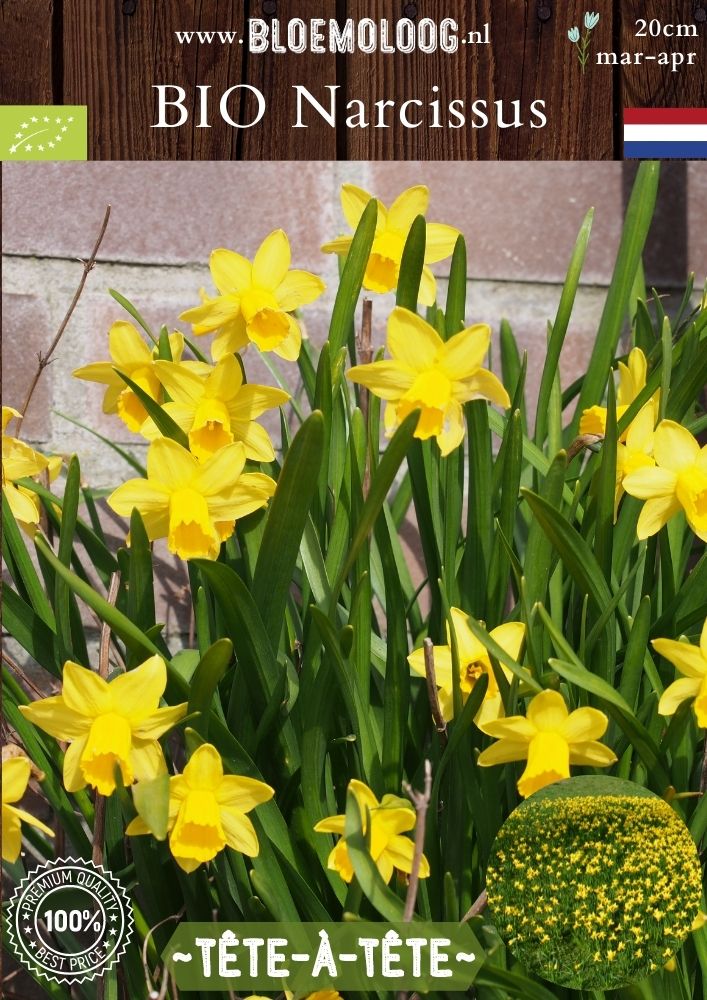Bloemoloog
Organic Narcissus 'Tête à Tête' - Daffodil | 10 pcs.
Organic Narcissus 'Tête à Tête' - Daffodil | 10 pcs.
Estimated Shipping Widget will be displayed here!
Couldn't load pickup availability
Organic botanical dwarf daffodil
Perhaps the most famous daffodil. The Narcissus 'Tête-à-Tête' is a low, yellow, botanical daffodil with charming small trumpet-shaped flowers. It reaches a height of about 20 centimeters and has one or more bluish-green flower stems per bulb, which protrude above the narrow, medium-long leaves. Each flower stem carries one or more flowers. This early flowering daffodil shows off its blooms for about 4 weeks in March and April.
She is very suitable as a cut flower, she smells wonderful.
Combine it with Muscari 'Armeniacum' or Tulipa 'Little Beauty'.
How, where and when do I plant daffodil bulbs?
An organic daffodil flowerbulb needs a cold period, so plant it in the ground from September to January. The planting depth is 2 to 3 times the height of the flowerbulb itself and the planting distance is 2 to 3 times the width of the flowerbulb itself. When planting in pots, the flowerbulbs may be planted closer together and may extend half above the ground for a decorative effect. However, after flowering, the flowerbulbs should be planted back in the garden, while maintaining the planting depth and spacing discussed.
Plant the daffodil 'Tête-à-Tête' in a sunny to semi-shaded spot in the garden, pot or lawn. Plant it in groups in a nutrient-rich, water-permeable, preferably calcareous, sandy soil, but it will also grow in clay soil. As long as the soil is well-drained and does not retain excess water. If you have clay soil, you can improve the soil by adding organic matter such as compost or well-rotted manure to improve drainage.
Daffodil bulbs are poisonous and are therefore avoided by rodents such as voles. Use them to protect other flowerbulbs by planting them through and around them.
Care of the daffodil
Provide organic nutrition during planting. Cut off the spent flowers at the top and let the rest of the foliage die. Only cut it off when the leaf has completely dried out. The daffodil 'Tête-à-Tête' is a strong species that naturalizes well. She comes back every year faithfully. Provide organic food annually for optimal results.
Propagation
For propagation, the flower bulb can be dug out at the beginning of summer. The flower bulb is dried and stored in a warm place. They can be planted again from September. Plant the small bulbs separately and provide organic nutrition so that the small flower bulbs grow quickly.
Origin of the daffodil
Tête-à-Tête is a hybrid daffodil, resulting from a cross between two species, likely Narcissus cyclamineus and another small-flowered daffodil. Narcissus cyclamineus is known for its graceful, swept-back petals and compact growth, traits also visible in Tête-à-Tête. This variety was developed by British plant breeder Alec Gray during the 1940s and 1950s. Gray specialized in creating smaller daffodils with refined shapes and excellent growing characteristics.
Buy Organic Narcissus 'Tête à Tête'
Skal NL-BIO-01 certified: 109459
Packed per 10 flower bulbs or choose a stacking discount!
Stacking discount: E
Can be ordered from June '25!
EU shipping €8.95 - Free shipping from €100 purchase.
Characteristics
| Flowering time: | March - April |
| Planting time: |
From September |
| Planting depth: |
10 cm deep |
| Planting distance: | 10 cm apart |
| Height: |
20 cm high |
| Flower diameter: |
5cm wide |
| Location: |
Partial shade, sun |
| Soil PH: | Clay, loam, sandy soil - Slightly acidic/neutral |
| Winter hardiness: |
Good hardy |
| Propagation: | Good (naturalizes) |
| Origin: | Western Europe |
| Family: | Amaryllidaceae (daffodil family) |
| Colour: | Yellow |
| Bee-friendly: | Yes |
| Fragrant: | Yes |
| Bulb size: | 12/14 |
Other daffodil varieties

NL-BIO-01
To share






